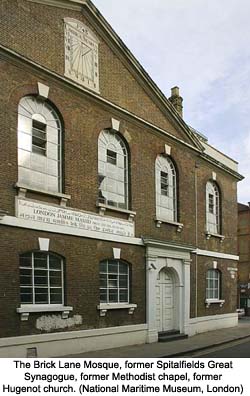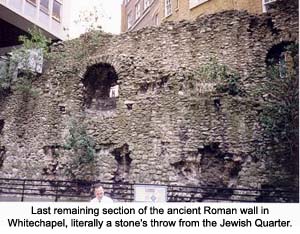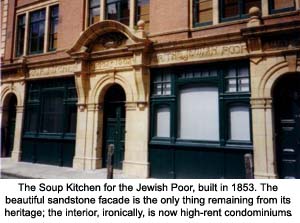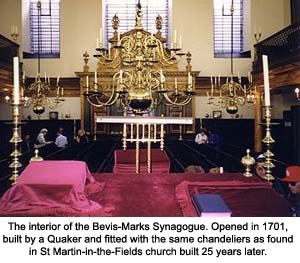A Walking Tour of London's Jewish Past
by Joseph Hayes
 A tour of London's Jewish past is full of
qualifiers, language with many references to former buildings,
places that "used to be" and use of the word
"original" -- sites of interest, with explanation. A tour of London's Jewish past is full of
qualifiers, language with many references to former buildings,
places that "used to be" and use of the word
"original" -- sites of interest, with explanation.
The area known as the East End is many hamlets adjoining the old
City of London, the Cockney section famously within hearing
distance of the bells of St. Mary-le-Bow church. From the Thames
River on the south border to Bethnal Green Road on the north and
Aldgate High Street, it is a place now known for theater and
tours of the notorious Tower, the home of Sherlock Holmes, the
Elephant Man and Jack the Ripper. Always a magnet for immigrants
searching for a better life in cosmopolitan London, it was also,
at the beginning of the 20th Century, home to an estimated
300,000 Jews, a Quarter with residents from Eastern Europe, Spain
and Portugal. With more than 150 synagogues before the start of
World War II, now there are only four, all of them at risk, and
an elderly Jewish population of less than 3,000.
Like the shifting fate of the Jewish people themselves, the cycle
of new immigration is never ending and life in the East End
continually changes. Part of the ancient Roman wall that once
surrounded Londinium is still standing, literally a stone's throw
from the oldest remaining Jewish house of worship. More of the
wall remains than signs of Jewish life, which in its turn
supplanted older, established communities. What is now called the
Brick Lane Mosque, the Bengali Jamme Masjid, was the Spitalfields
Great Synagogue in the 19th century -- but before that it was a
Methodist chapel, and before that a church for Hugenots escaping
persecution in France. Punjabis, Somalis and expats from Pakistan
and Bangladesh currently fill apartments and own shops that once
held Kosher butchers and bookstores of rabbinical study. But the
Jewish history of London has left its mark, as can be seen by
walking the Quarter with an educated eye.
 The first published mention of a Jewish quarter in
London was in 1128, although their presence has been felt at
least from the time of the Norman Conquest in 1066. Jewry Street
in London's financial center was where Jews settled both before
their expulsion in 1290 and after the resettlement, 350 years
later. From the late 1800s to just before WWII, thousands of Jews
from Poland, Romania and Russia arrived in England, many crowding
into the two square miles of Whitechapel and Stepney, close to
where their ships had docked. My own grandfather, fleeing the
dual anti-Semitism of the Reich and Tsarist pogroms, passed
through London on his way from Russia to America. The first published mention of a Jewish quarter in
London was in 1128, although their presence has been felt at
least from the time of the Norman Conquest in 1066. Jewry Street
in London's financial center was where Jews settled both before
their expulsion in 1290 and after the resettlement, 350 years
later. From the late 1800s to just before WWII, thousands of Jews
from Poland, Romania and Russia arrived in England, many crowding
into the two square miles of Whitechapel and Stepney, close to
where their ships had docked. My own grandfather, fleeing the
dual anti-Semitism of the Reich and Tsarist pogroms, passed
through London on his way from Russia to America.
He would have heard merchants in the old markets and bnarrow
streets of Petticoat Lane and Brick Lane, pushing wooden carts
and shouting prices in Yiddish. Cabinet makers, tailors,
shoesmiths and cigarette makers literally rubbed shoulders with a
thriving community of actors continuing the great tradition of
Yiddish theater. Yards of dyed fabric stretched across the
"tenter grounds" of Spitalsfield Fields, home of dozens
of cloth makers, a section of town that became for a brief time
part of the "playground" of Jack the Ripper -- several
witnesses to the heinous crimes (as well as a few suspects) were
local Jews.
 The phantom remnants of the East End's Jewish
past are all around. Rectory Square holds a Victorian apartment
building now called Temple Court, once the East London Synagogue,
and still contains Moorish tile interiors, stained glass and
commemorative plaques. The beautiful sandstone facade is the only
thing remaining from the heritage of the Soup Kitchen for the
Jewish Poor in Brune Street, opened in 1902 to feed indigent
local residents. The interior, ironically, is now high-rent
condominiums. The Whitechapel offices of the Jewish Daily News,
closed for decades, still carries a Star of David sign that
currently hangs above a men's clothing store. A similar Star is
carved into the façade of a building on Bethnal Green Rd,
an artist's studio that was once Bethnal Green Great Synagogue.
Walking on to Brick Lane, the only remnants of a thriving Jewish
social scene are two bagel shops, where Kosher meals are still
available for the discerning. Princelet Street Synagogue became a
museum, now derelict and closed, and the New Road Synagogue is a
clothing factory. The phantom remnants of the East End's Jewish
past are all around. Rectory Square holds a Victorian apartment
building now called Temple Court, once the East London Synagogue,
and still contains Moorish tile interiors, stained glass and
commemorative plaques. The beautiful sandstone facade is the only
thing remaining from the heritage of the Soup Kitchen for the
Jewish Poor in Brune Street, opened in 1902 to feed indigent
local residents. The interior, ironically, is now high-rent
condominiums. The Whitechapel offices of the Jewish Daily News,
closed for decades, still carries a Star of David sign that
currently hangs above a men's clothing store. A similar Star is
carved into the façade of a building on Bethnal Green Rd,
an artist's studio that was once Bethnal Green Great Synagogue.
Walking on to Brick Lane, the only remnants of a thriving Jewish
social scene are two bagel shops, where Kosher meals are still
available for the discerning. Princelet Street Synagogue became a
museum, now derelict and closed, and the New Road Synagogue is a
clothing factory.
War has always had an effect on the East End. It was from this
area that many of the volunteers for what became known as The
Jewish Legion were recruited, sent in 1917 to liberate Palestine
from Turkish rule. There has been a great deal of reconstruction,
as the area, so close to strategic docks, became a prime target
for German bombing during the Second World War. The Philpot St.
Great Synagogue and its attached shul (Hebrew school) were
obliterated by German warplanes.
 But some houses of worship remain. Fieldgate Street
Great Synagogue, founded in 1899, is a tiny building dwarfed by
the giant East London Mosque now beside it. Nearby is Rowton
House, a lodging house where Lenin, Stalin and Trotsky lived
while in exile. Much larger and grander is Bevis Marks,
constructed for the Sephardic (Spanish/Portuguese) Jewish
community in 1658 by a Quaker who refused to take payment for
building a "holy place", and fitted with the same
chandeliers as found in the church of St. Martin-in-the-Fields
built 25 years later. The synagogue, originally called Shar
HaShamayim ("Gate of Heaven") is the UK's oldest,
modeled after the Portuguese Synagogue in Amsterdam and built
inside a courtyard, hidden from view at a time when synagogues
were not permitted on public streets. But some houses of worship remain. Fieldgate Street
Great Synagogue, founded in 1899, is a tiny building dwarfed by
the giant East London Mosque now beside it. Nearby is Rowton
House, a lodging house where Lenin, Stalin and Trotsky lived
while in exile. Much larger and grander is Bevis Marks,
constructed for the Sephardic (Spanish/Portuguese) Jewish
community in 1658 by a Quaker who refused to take payment for
building a "holy place", and fitted with the same
chandeliers as found in the church of St. Martin-in-the-Fields
built 25 years later. The synagogue, originally called Shar
HaShamayim ("Gate of Heaven") is the UK's oldest,
modeled after the Portuguese Synagogue in Amsterdam and built
inside a courtyard, hidden from view at a time when synagogues
were not permitted on public streets.
Sandy's Row Synagogue, founded by Dutch immigrants in
Spitalfields in 1854, is in the opposite direction from Fieldgate
Street, as is the Nelson Street Synagogue, the last to be built
in the East End in 1923. And much like Brick Lane, the Mile End
and Bow Synagogue is now a Gurdwara, a Sikh place of worship, its
marble front step covered with the shoes of the devotees
inside.
As the Jewish community thrived and life shifted west and north
to London's suburbs, the changing population brought a change in
local shops. Hessel Street Market, Frumkins wine merchants, even
legendary delicatessen Blooms Kosher (reputed to have England's
rudest waiters) eventually closed. Long gone, Feldman's Post
Office on Whitechapel Road was the homing beacon for many new
immigrant Jews to London, a place to find lodging, relatives,
even a loan. The voices on Petticoat Lane now have an Eastern
rhythm as the Market, once the mainstay of the Jewish community,
provides familiar staples for the East End's current residents.
Landmarks of the Jewish past are worth seeking out. The St.
Swithen's Lane house of Benjamin Disraeli, Queen Victoria's Prime
Minister, still stands, as does the headquarters of the
Rothschild corporation, whose founder, Nathan Meyer Rothschild,
is buried in the Brady Street Cemetery, a Reformed Jewish burial
ground closed since 1858.
If my grandfather could walk the Jewish Quarter now, there would
be little there for him to recognize, aside from the feeling of
new immigrants seeking a better life on its still-cobbled
streets.
More Information:
We regret that we no longer have the resources to maintain up-to-date links and/or hours and pricing details for the various sites and attractions listed on this website. For more information about the location(s) listed above, please use your favorite search engine or visit Wikipedia.
Freelance journalist Joseph Hayes writes for print and online publications worldwide. His plays have been performed in New York, California, Florida, Oregon and England. Hayes' most recent publications include the Eyewitness Travel Guide: Walt Disney World Resort & Orlando for Dorling Kindersley, and pieces in Style1900 and the Orlando Sentinel. He is cofounder of The Burry Man Writers Center (http://www.burryman.com), a worldwide community of writers, and also hosts a personal site at http://www.jrhayes.net.
Article and photos © 2006 Joseph Hayes
|
